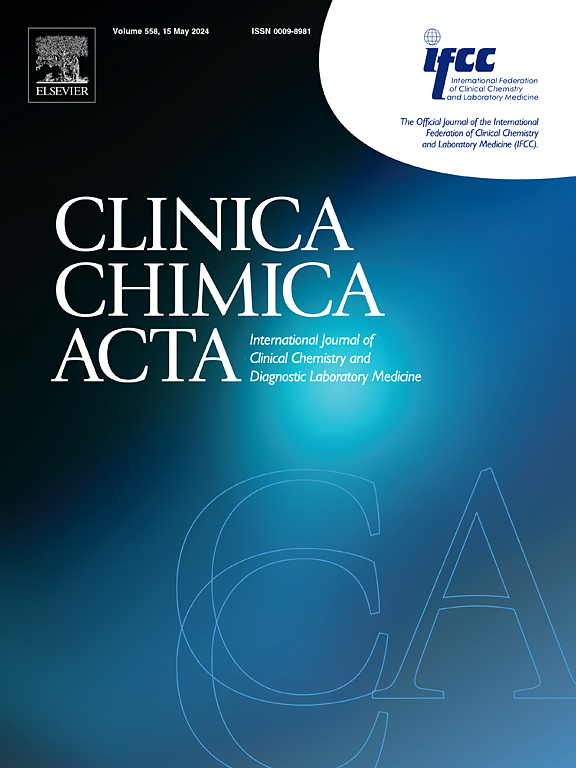同时分析血浆中 2-hydroxybutyrate 和 2-hydroxyisobutyrate 的 HPLC-MS/MS 方法:开发与临床意义。
IF 2.9
3区 医学
Q2 MEDICAL LABORATORY TECHNOLOGY
引用次数: 0
摘要
最近的研究发现了糖尿病与短链脂肪酸(包括 2-羟基丁酸(2-HB)和 2-羟基异丁酸(2-HiB))之间的关系;2-HB 与胰岛素抵抗的早期阶段有关,而 2-HiB 则与 1 型糖尿病并发症的风险和进展有关。它们在人体中的代谢和病理生理作用尚未完全明确。我们采用一种新型的质谱分析法研究了 2-HB 和 2-HiB 与糖尿病之间可能存在的联系,该分析法能够区分血浆中的 2-HiB 和 2-HB 与它们的 HB 异构体。准确度和精密度(RSD%)始终分别在 99-102% 和 0.7-3.5% 之间。研究涉及正常糖耐量(NGT)和 2 型糖尿病(T2D)受试者的样本,这些样本最初被纳入一项研究动脉粥样硬化血栓形成机制的多中心研究中。正常糖耐量受试者的 2-HB 和 2-HiB 浓度分别为 61 (36) 和 3.1 (1.9) µmol/L,中位数(四分位间距)明显低于 2 型糖尿病患者,后者的浓度分别为 74 (4.0) 和 3.8 (2.9) µmol/L。这些分子与临床和代谢变量的关联模式存在部分差异:两种化合物都与男性性别、体重指数、HbA1c 和血浆葡萄糖直接相关,2-HiB 还与年龄、收缩压和高密度脂蛋白胆固醇相关。此外,它们还与游离脂肪酸、甘油和甘油三酯浓度相关,但后者与 2-HB 呈负相关,而与 2-HiB 呈正相关。结果证实了 2-HB 和 2-HiB 与 T2D 代谢特征的不同关联具有临床意义。本文章由计算机程序翻译,如有差异,请以英文原文为准。
HPLC-MS/MS method for simultaneous analysis of plasma 2-hydroxybutyrate and 2-hydroxyisobutyrate: Development and clinical significance
Recent studies have identified relationships between diabetes mellitus and short-chain fatty acids, including 2-hydroxybutyrate (2-HB) and 2-hydroxyisobutyrate (2-HiB); 2-HB has been associated to the early stages of insulin resistance, while 2-HiB with the risk and progression of complications of Type 1 diabetes. Their metabolism and pathophysiological role in humans are not fully clarified.
The possible association between 2-HB and 2-HiB and diabetes mellitus was investigated with a novel mass spectrometry-based assay, capable of discriminating plasma 2-HiB and 2-HB from their HB isomers. Accuracy and precision (RSD%) were always in the range 99–102% and 0.7–3.5%, respectively. The study involved samples from subjects with normal glucose tolerance (NGT) and Type 2 diabetes (T2D), originally included in a multicenter study investigating mechanisms involved in atherothrombosis.
NGT subjects exhibited concentrations of 2-HB and 2-HiB of 61 (36) and 3.1 (1.9) µmol/L, median (interquartile range), respectively, that were significantly lower than those of the T2D patients, whose values were 74 (4.0) and 3.8 (2.9) µmol/L, respectively. The pattern of association of these molecules with clinical and metabolic variables is partially different: both compounds were directly related to male sex, BMI, HbA1c, and plasma glucose, 2-HiB also with age, systolic blood pressure, and HDL-cholesterol. Furthermore, they correlate with free fatty acids, glycerol, and triglyceride concentrations, but the latter correlation was negative for 2-HB and positive for 2-HiB.
Results confirmed the clinical significance of 2-HB and 2-HiB, in differential association with metabolic features of T2D.
求助全文
通过发布文献求助,成功后即可免费获取论文全文。
去求助
来源期刊

Clinica Chimica Acta
医学-医学实验技术
CiteScore
10.10
自引率
2.00%
发文量
1268
审稿时长
23 days
期刊介绍:
The Official Journal of the International Federation of Clinical Chemistry and Laboratory Medicine (IFCC)
Clinica Chimica Acta is a high-quality journal which publishes original Research Communications in the field of clinical chemistry and laboratory medicine, defined as the diagnostic application of chemistry, biochemistry, immunochemistry, biochemical aspects of hematology, toxicology, and molecular biology to the study of human disease in body fluids and cells.
The objective of the journal is to publish novel information leading to a better understanding of biological mechanisms of human diseases, their prevention, diagnosis, and patient management. Reports of an applied clinical character are also welcome. Papers concerned with normal metabolic processes or with constituents of normal cells or body fluids, such as reports of experimental or clinical studies in animals, are only considered when they are clearly and directly relevant to human disease. Evaluation of commercial products have a low priority for publication, unless they are novel or represent a technological breakthrough. Studies dealing with effects of drugs and natural products and studies dealing with the redox status in various diseases are not within the journal''s scope. Development and evaluation of novel analytical methodologies where applicable to diagnostic clinical chemistry and laboratory medicine, including point-of-care testing, and topics on laboratory management and informatics will also be considered. Studies focused on emerging diagnostic technologies and (big) data analysis procedures including digitalization, mobile Health, and artificial Intelligence applied to Laboratory Medicine are also of interest.
 求助内容:
求助内容: 应助结果提醒方式:
应助结果提醒方式:


